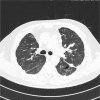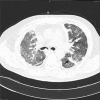Apatinib for the treatment of pulmonary epithelioid hemangioendothelioma: A case report and literature review
- PMID: 29137048
- PMCID: PMC5690741
- DOI: 10.1097/MD.0000000000008507
Apatinib for the treatment of pulmonary epithelioid hemangioendothelioma: A case report and literature review
Abstract
Rationale: Pulmonary epithelioid hemangioendothelioma (P-EHE) is a rare tumor, with no established standard treatment. Overexpression of vascular endothelial growth factor receptor 2 (VEGFR-2) has been reported in some P-EHE patients. Apatinib, a new small molecule tyrosine kinase inhibitor that specifically targets VEGFR-2, has therapeutic benefits in some advanced tumors. However, its efficacy in P-EHE cases has not been reported.
Patient concerns: Herein, we presented a 44-year-old man with recurrent hemoptysis for approximately 9 years.
Diagnoses: After hospitalization, relevant examinations were conducted. The disease was subsequently diagnosed as P-EHE.
Interventions: The patient underwent pulmonary lobectomy, but subsequently developed multiple metastases. Within the tumor, CD31, CK, and Vimentin were found to be positive, while CD34 was negative. Apatinib was initially administered 250 mg daily doses and after 1 month was increased to 500 mg daily.
Outcomes: He showed noticeable symptomatic improvements and positive imaging changes in the first month of treatment. However, the disease progressed in the following month, despite the increased apatinib dose.
Lessons: Apatinib is possibly a new treatment for P-EHE. However, further clinical trials are necessary to confirm an effective dose and the efficacy and safety of apatinib in P-EHE treatment.
Conflict of interest statement
The authors have no conflicts of interest to disclose.
Figures



References
-
- Corrin B, Manners B, Millard M, et al. Histogenesis of the so-called “intravascular bronchioloalveolar tumour”. J Pathol 1979;128:163–7. - PubMed
-
- Weiss SW, Enzinger FM. Epithelioid hemangioendothelioma: a vascular tumor often mistaken for a carcinoma. Cancer 1982;50:970–81. - PubMed
-
- Travis WD, Brambilla E, Nicholson AG, et al. The 2015 World Health Organization Classification of Lung Tumors: impact of genetic, clinical and radiologic advances since the 2004 classification. J Thorac Oncol 2015;10:1243–60. - PubMed
-
- Rojas-Vigott R, Castro CM, Mendez SR. Pulmonary-epithelioid hemangioendothelioma: a case report of spontaneous regression: track: supportive care and others. J Thorac Oncol 2016;11:S231–2. - PubMed
-
- Kitaichi M, Nagai S, Nishimura K, et al. Pulmonary epithelioid haemangioendothelioma in 21 patients, including three with partial spontaneous regression. Eur Respir J 1998;12:89–96. - PubMed
Publication types
MeSH terms
Substances
LinkOut - more resources
Full Text Sources
Other Literature Sources
Medical
Research Materials

